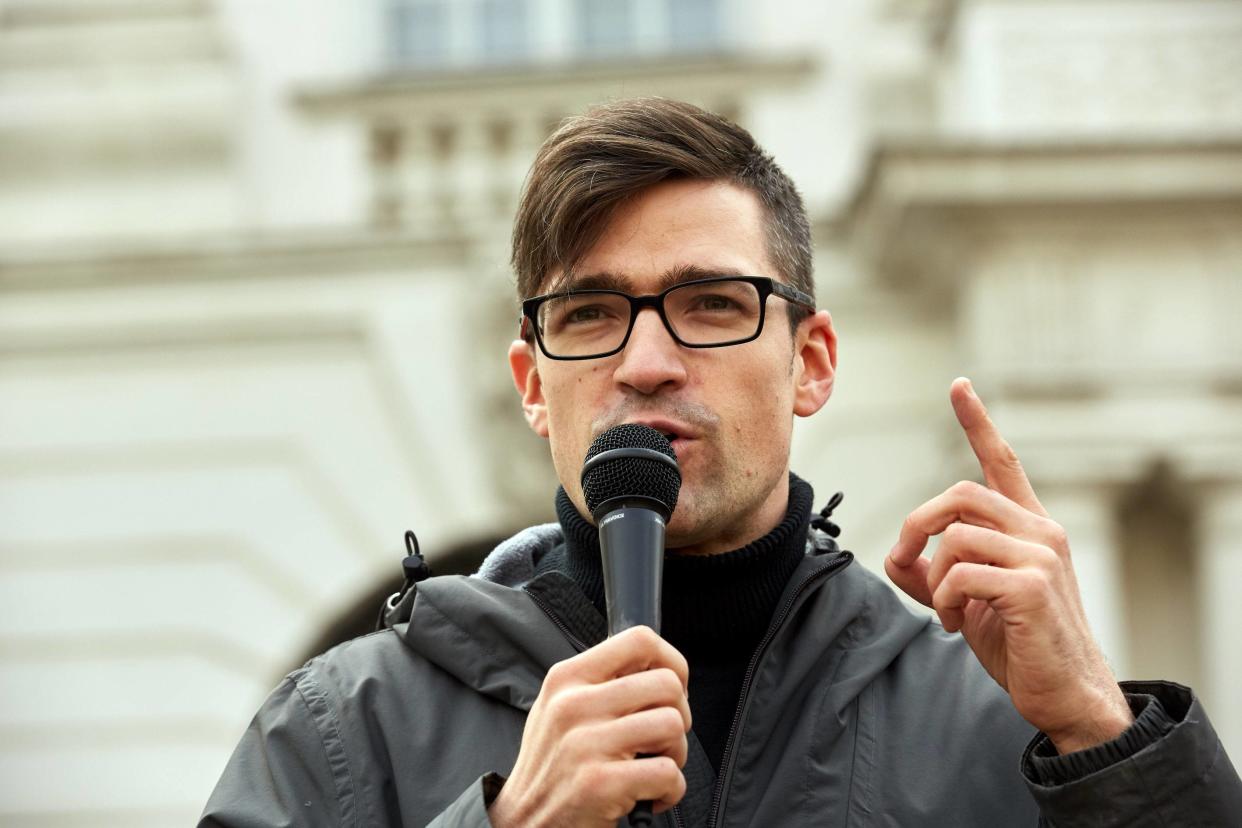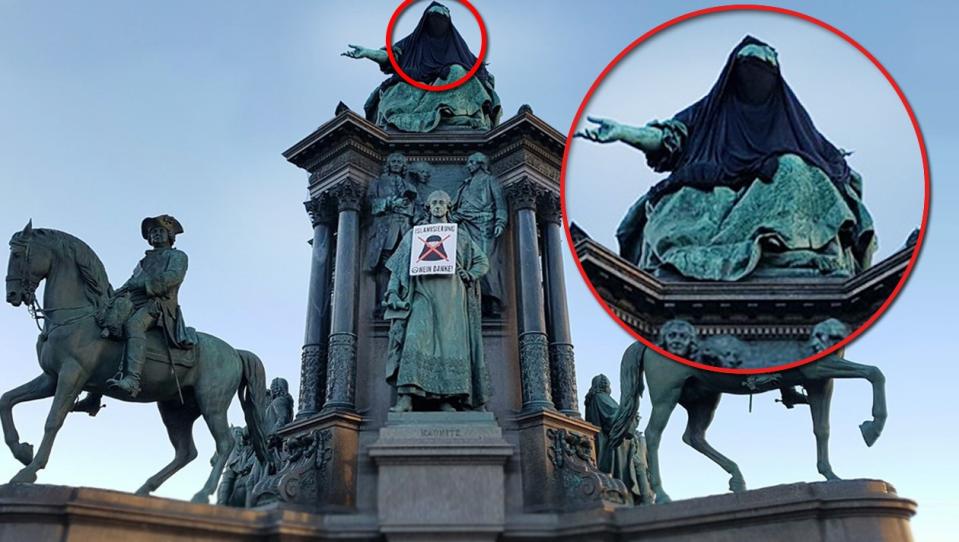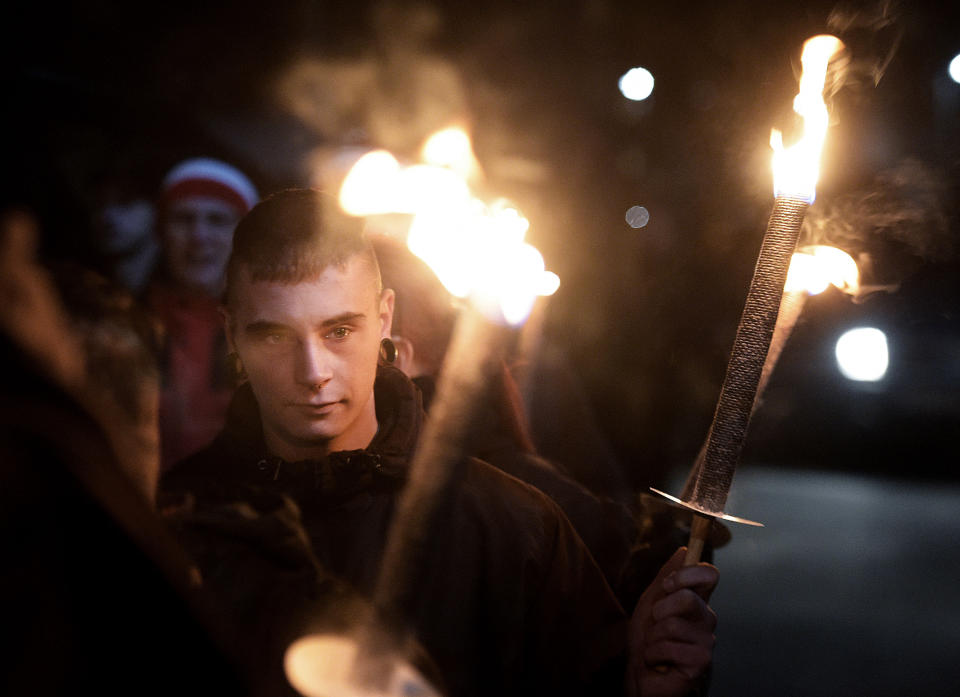'Great Replacement' ideology is spreading hate in U.S. and across the globe

BARCELONA — “I just had a house raid by the police,” Martin Sellner said last weekend from his apartment in Vienna, where he makes YouTube videos, sometimes in his kitchen, warning about the dangers of multiculturalism and how Muslim immigrants are replacing the white population across Europe.
This wasn’t the first time Austrian authorities have taken an interest in the articulate, engaging 30-year-old activist, known for the “actions” he plots as one of the leaders of an ethno-nationalist movement known as Generation Identity. Its members, believed to number about 10,000, are fighting back against what they consider Europe’s forced “Islamization” and a “dilution” of its original genetic stock.
But last week’s sweep of Sellner’s apartment wasn’t the result of Generation Identity’s usual stunts — like throwing a giant burqa over the head of a 65-foot-high statue of revered Austrian archduchess Maria Theresa with a sign saying “Islamization — No Thanks!” or chartering a boat to hinder rescue vessels from picking up drowning Africans whose dinghies capsized in the Mediterranean.
This raid concerned a donation — a gift of 1,500 euros (over $1,800), one of the biggest in Generation Identity’s seven-year existence. The donor was Brenton Tarrant, accused of opening fire on two mosques in Christchurch, New Zealand, leaving 50 dead. This was the second time police raided Sellner’s apartment to investigate his connections with Tarrant, seizing his phones, cameras and computers. Sellner protests that there aren’t any links — Tarrant was just “a random Australian guy” whom he thanked via email in 2018 for his donation and invited to share a beer if he visited Vienna.
Even if they never met to share a pitcher, Sellner and Tarrant share a controversial belief, one that’s integral to Generation Identity and to scores of extremist groups worldwide: the Great Replacement of white Christians by dark-skinned “invaders,” an idea that is driving right-wing politics in many European countries — and has echoes in the United States, not just in politics, but in terror attacks against minorities and Jews.

Sellner views the Great Replacement as “a mathematical fact,” the result of cultural, political and economic decisions made over recent decades. “Since the ’60s and ’70s, Europe’s population [of indigenous white Europeans] has been shrinking,” he says, largely because white European women, like their American counterparts, were not bearing the 2.1 children considered necessary to maintain a stable population. But Europe’s population is rising — due to the influx of immigrants, or what he calls “replacement migration.”
That part, statistics show, is true at least in some countries: The numbers of incoming immigrants have offset deaths in European nations, such as Germany and Sweden, leading to overall population growth.
But the Great Replacement theory goes entirely off the rails when proponents, such as Sellner’s group, assert, as they do on the Generation Identity website, that “Low birth rates of German and European people and simultaneous massive Muslim immigration will turn us into minorities in our own countries in a few decades,” leading to “the disappearance of Germans and Europeans in their own countries."
Even given the higher birthrate of immigrants, that’s an unlikely scenario, according to demographer Landis Mackellar of the Population Council and editor of Population and Development Review. “The Great Replacement and statements attributed to Generation Identity distort the demographic and sociological evidence,” he says.
Hélène Ducros, human geographer at Columbia University's Council for European Studies, questions what data the group is using to make such projections. Some European countries, like France, don't ask about ethnicity or religion on their census forms, making statistics unreliable, and many "migrants" into European countries actually come from other European countries. "The reality is that Europe — in the largest sense, not just the EU — has always been a continent where people moved around a lot," she says. "I would say that mobility, and thus intermixing, is what characterizes Europeans across time, not ethnicity."

A report from the Pew Research Center released in late 2017, “Europe’s Growing Muslim Population,” estimated the number of Muslims in Europe to be less than 5 percent. Even using the highest estimates for migration rates, the report estimated that in 2050, the number of Muslims continent-wide would be around 14 percent.
Sellner counters that going further out on the timeline, “if you just continue the trend, the population decline plus the replacement migration will lead to a total replacement.” Despite its shaky premises, the concept of the Great Replacement is so potent that it has inspired mass shootings. Beyond Tarrant — who was so moved by it that he titled his 74-page manifesto about his attack “The Great Replacement” — authorities believe it motivated the synagogue shooter in Pittsburgh who killed 11 in October; the Poway, Calif., synagogue shooter who killed one and injured three worshippers in the spring; and Dylann Roof, who in 2015 gunned down nine African-Americans in a Charleston, S.C., church. Echoes of it showed up in the ramblings of Anders Breivik, who killed 77 in Norway in 2011 “in defense of my culture and my people,” and Timothy McVeigh, the Oklahoma City terror bomber of 1995, owned a copy of a novel based on its ideas.
A leitmotif in neo-Nazi circles, the Great Replacement may have also motivated the neo-Nazi-linked fatal shooting in early June of German politician Walter Lübcke, who supported the immigration policies of German chancellor Angela Merkel, as well as the threats posted by two neo-Nazis in Britain to Prince Harry, who was called a “race traitor,” evidently for having a child with his biracial wife, Meghan Markel. It could be heard in the chants of white supremacists who marched in Charlottesville, Va., yelling, “You will not replace us” and “Jews will not replace us.” A white supremacist who drove into a crowd of counter-demonstrators, killing one, was sentenced Friday to life in prison for hate crimes.
The Great Replacement theory is also believed to be one factor in the push to outlaw abortion in the United States.

As in much of Europe, in the U.S. “the white population is getting older, which means proportionately few white women are in their childbearing years,” says William Frey, author of “Diversity Explosion” and in-house demographer at Brookings Institute. As of last year, he wrote, “for the first time there are more children [in the U.S.] who are minorities than who are white, at every age from zero to nine.”
That’s just a hint at the changing ethnicity of America. Frey says that across the entire U.S. population, the percentage of whites — or “non-Hispanic whites” as they are called in the census — is projected to dip below the 50 percent mark in about 25 years.
That shift in racial balance is earth-shaking for some. According to Keegan Hankes, a research analyst for the Southern Poverty Law Center’s Intelligence Project, that predicted demographic change — the projection that “by 2040, or around then, whites will no longer be an absolute majority is … the No. 1 driver in anxiety for people who join these [hate] groups.”
He says the number of hate groups in the United States is rising, with white supremacist groups, only one subset of the hate groups tracked by the SPLC, jumping from 100 to 150 last year. “White nationalism is the ideology at the core” of the Great Replacement, he says, defining it as “based on a conspiratorial idea that these demographic changes are the product of a calculated plan of enemies of the white race.”
Indeed, Great Replacement adherents often assign blame for ethnic shifts to a conspiracy, by plotters whose identity varies depending on which group is pointing fingers.
Sellner believes that “replacement migration” was a deliberate decision by liberal politicians and big enterprises who “wanted cheap labor,” as well as by certain (unspecified) agents hoping to achieve “a dilution of the indigenous (European) population” and impose “multiculturalism to overcome nationalism and European identity.” And to counteract the influx of immigrants, Generation Identity is demanding drastic cuts in immigration and the deportation and “repatriation” of immigrants already on the Continent. They refer to this as the “Reconquista” of Europe by white Christians, a name borrowed from Spain’s 15th century military campaign to push out Muslims and Jews.

Sellner says his movement isn’t racist and doesn’t advocate violence. Tarrant, however, took the idea to a new level in the document he sent to politicians before allegedly storming Christchurch mosques. Explaining his motivation, Tarrant’s “Great Replacement” manifesto begins with “It’s the birthrates, it’s the birthrates, it’s the birthrates…”
“Why did you target those people?” Tarrant, who considers himself of European origin, writes of his attack on Christchurch Muslims. “They were an obvious, visible and large group of invaders, from a culture with higher fertility rates … that seek to occupy my people’s lands and ethnically replace my own people…”
Viewing immigrants, especially dark-skinned Muslims, whether from Africa or Asia, as “invaders” is commonplace for many who buy into the Great Replacement idea, including the man generally credited with devising the phrase, French writer Renaud Camus. In 2012, Camus (no relation to Albert Camus) published a nonfiction book with that title warning of the cultural dangers of Muslim immigrants in France. He said in an interview last year that “too often, for us, by their number, by their behavior, by their growing attachment to their cultures, manners and religion of origin, they have become, with a few exceptions, invaders, conquerors, and colonizers.”

But the ideas in his book — and others of the “Muslim horror genre” such as Bat Ye'or’s “Eurabia” and Michel Houellebecq’s “Submission” — go back decades, to the 1960s and ’70s when guest workers were invited from countries such as Turkey and Algeria for jobs in construction, mining and transportation. In 1973, when the worldwide oil crisis slammed the brake on many European economies, jobs for guest workers dried up, but many chose to stay. It was that year that Jean Raspail unleashed his macabre vision of France besieged by dark-skinned invaders in the stomach-wrenching novel “The Camp of the Saints,” a book often referenced by proponents of the Great Replacement. In a 2015 radio broadcast, future White House strategist Steve Bannon remarked that the flood of refugees fleeing civil war in Syria was “almost a Camp of the Saints-type invasion into Central and then Western and Northern Europe.”
Other extremists and rabble-rousers in the web of far-right hate groups, including Jason Kessler, who organized the 2017 Charlottesville “Unite the Right” rally, spin the Great Replacement into a “white genocide” plot foisted on civilization by a shadowy global elite, the European Union, United Nations, attendees at the World Economic Forum in Davos, feminists and/or Jews. That “white genocide” terminology stems from “The Turner Diaries,” an apocalyptic novel published in 1978 by American neo-Nazi William Luther Pierce, who envisioned a disarmed white populace, beaten down by a black majority led by Jews, who are overthrown by a band of white supremacist guerrillas, known as “the Order.” When Timothy McVeigh was arrested, a copy of “The Turner Diaries” was found in his car.
Neo-Nazi David Lane, part of the Order, a real-life terror group modeled on the one in the novel, added more touches to that idea: While serving a 190-year sentence in prison for racketeering, conspiracy and his involvement in the 1984 murder of Alan Berg, a Jewish radio host, he penned the “White Genocide Manifesto” and a slogan called the Fourteen Words: “We must secure the existence of our people and a future for white children.” The number 14, which stands as neo-Nazi code for that phrase, was scrawled on one of Tarrant’s weapons, and shortly before the attack in Charleston, Dylann Roof was photographed on a beach, kneeling before a sand image with that number and 88, code for “Heil Hitler.” John Earnest, who opened fire at the synagogue in Poway, wrote in a letter explaining his actions that “Every Jew is responsible for the meticulously planned genocide of the European race.”

Some European political figures are now referencing the “Great Replacement” in their speeches and policies, among them Heinz-Christian Strache, the leader of Austria’s Freedom Party and vice chancellor of that country, until he resigned in a recent unrelated scandal. “Italy’s Matteo Salvini and Hungary’s Viktor Orbán have mentioned replacement theory,” says Louie Dean Valencia-García, an assistant professor of Digital History at Texas State University, who is editing a book about the role of small publishers and the distortion of history by the far right.
“They take the ideas of the identitarian movement and put them in a framework that is more sanitized and palatable” he says, couching them in broader terms like “Western civilization.” It usually means, he says, “we don’t want brown people in Europe.”
As he studied the emergence of identitarians and white-power groups, Valencia-García has come to believe that they share “an obsession with a purity that’s usually imagined” and is based on an imagined history refashioned for their purposes, and conflating Caucasian ancestry with Christian culture. Throughout history, says Andrew Wilson, a sociologist who teaches at the University of Derby, in England, and writes about the conspiratorial elements of extremist groups, “we see a constant interplay of cultures”— including how the Renaissance kicked off because of writings from ancient Greeks and Romans that had been translated and preserved by Muslims during the Middle Ages. The groups pushing the Great Replacement, he says, are trying to portray “monolithic cultures which they perceive as being under threat.” It taps into an ideology in which “they are being persecuted” often by “a group secretly working behind the scenes.”

“Culture is always changing — that is the nature of culture,” Valencia-García says. “Having a fixed identity is impossible.” For Valencia-García, it all raises the question, “What is white anyway?” He says it’s a relatively novel concept, first given importance in the 1800s. “The idea of whiteness,” he says, “is a new category that humans use to divide themselves.”
Demographer Frey notes that in the 1920s, immigrants from Southern and Eastern Europe were considered a threat to American culture, leading to harsh immigration laws restricting their entry. In fact, they were viewed as such a liability to the American blood line that eugenicists were consulted to help draft laws banning intermarriage. Yet today, of course, citizens whose ancestors came from countries such as Italy, Greece or Spain are considered “white” while those with origins in Central and South America, with Spanish surnames, are counted as “Hispanic” regardless of their skin color. The ethnic group that is becoming a smaller share of the U.S. population is, in census terms, “non-Hispanic white.” If Hispanics were counted as white — which many consider themselves to be — the issue of “white replacement,” in the U.S. at least, could be solved merely by changing a box on the census form.
Melissa Rossi is a U.S. journalist based in Western Europe.
_____
Read more from Yahoo News:

